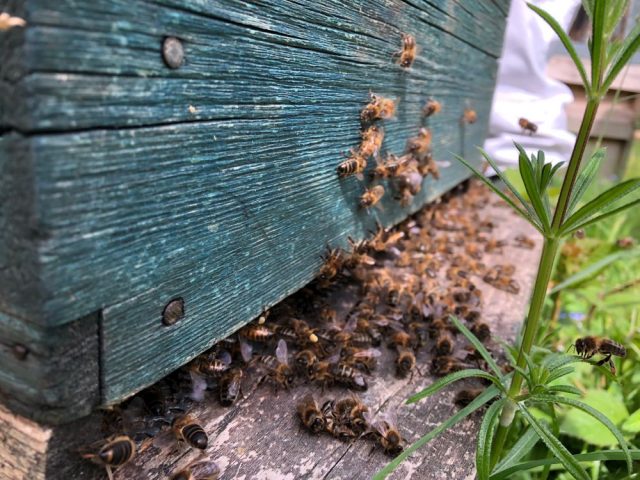Last weekend I went on a very enjoyable mini bee safari at the home of two Cornwall Beekeepers Association members. For their privacy I won’t give any names and shall just say the location was central Cornwall.
A bee safari means you get to look in other people’s hives and then enjoy a cup of tea afterwards while talking about bees. The perfect way to spend a sunny morning, no?
There was a wide spectrum of beekeeping experience between us all, ranging from those who had never held a frame before to experienced beekeepers of many stings. The beginners were able to inspect through a hive for the first time and see a range of different beekeeping dilemmas.
I do like these sturdy queen excluders.
It was particularly interesting to look inside a hive which was possibly queenless – our host wasn’t sure. On one of the first frames, multiple eggs in some cells were observed. It was discussed that this was likely to be laying workers, as while the eggs were at the bottom of the cells, they were considered to be short cells.
After some discussion about what could be done to rescue this hive full of laying workers, one of our hosts raised an objection – she had spotted some cells which had just one egg at the bottom. Were we sure this hive was queenless?
The next frame was lifted out for inspection. This contained a mixture of capped and uncapped brood. Case closed and no action needed! Just to confirm things even further, queenie was spotted and efficiently marked in a sponge plunger style cage. I was pleased to see this demonstrated as I bought one of these cages recently, having only used the crown of thorns style press-in cage before. The trickiest part of the process was getting the queen in, as she was quite a runner. It was commented that this was a two person job – one person to hold the frame up, the other to catch the queen in the cage.
Ron Mishka’s recent blog post ‘At least one of these bees is a laying worker‘ has a good explanation of how laying workers come about, how to tell the difference between a laying worker and a newly laying queen and what to do about laying workers. Even if you know all this already, you should follow Ron’s blog because it’s great!
The pleasurable morning was capped off by tea and coffee accompanied by multiple types of home made cake – rock cakes (delicious), cheese scones which one person commented were among the best they’d ever had, a cake I think contained honey… plus biscuits and wrapped mini swiss rolls.
Back at my hives, my spring of bee chaos continues. I’ve combined one of the weak swarm nucs into my strong yellow colony, as it seemed to be queenless and struggling. The nuc you see on the left also seemed to be queenless, so I gave it a test frame of eggs. When I inspected last week they had created a capped queen cell from the test frame – but I stupidly turned the frame over to inspect it without thinking, which may have dislodged the growing queen. I realised my mistake the instant I turned it upside down 😦
The nuc you see below is my strong one, and the only colony I have in which the queen is really going for it with laying. I’ve taken two test frames of eggs from this so far! Thank you queenie – at some point I’ll have to give you a name.






So, I liked the post but there’s a lot of beekeepers-lingo that went over my head . . . including rock cake (my teeth are not strong enough).
LikeLike
Oh dear, so even the cake talk went over your head! Think rock cakes are so named because they look like rocks. Their texture is not at all hard, more soft and crumbly like scones, and they are studded with raisins.
LikeLike
You had me interested until . . . raisins!!
LikeLike
I have noticed that men tend not to be into raisins.
LikeLike
Soak them in rum or brandy first.
LikeLike
It’s not a gender issue . . . it’s that they’re a nasty surprise when someone is expecting chocolate chips.
LikeLike
Yes, I’m perfectly happy with raisins, but if I expected chocolate then the raisins are a bitter disappointment.
LikeLike
I use a sponge plunger to mark queens. When I am alone I make sure that the paint pen and plunger are in my pocket so that I don’t have to walk away once I have found HRH. I can then set the frame flat on the hive and use two hands to catch her in the plunger gizmo. With practice it becomes easier. I typically get 0-2 workers with her. These can be released by carefully removing the plunger while the Queen is up on the top.
LikeLike
Thanks Tim, that is a good tip. I am sure my first few attempts at it will be very comical.
LikeLike
We are lucky to have several bee keeping friends close-by and we had an English afternoon tea to chat early in the year. I do think cakes attract beekeepers. The other benefit of these meetings is that it spares non-beekeeping friends and spouses the agony of listening to incessant talk about bees :).
I bought and painted my first white poly nuc some years ago. This year we bought another white poly nuc but I can’t remember why I painted it ??? Can you help? Amelia
LikeLike
Ah yes, strangely not everyone wants to talk endlessly about bees – weirdos!
I was told to paint the nuc to help protect it against the elements. I’m not sure whether you have as many elements in France?
LikeLike